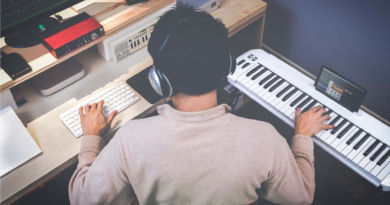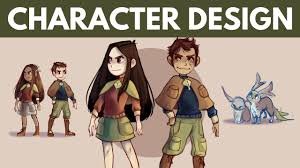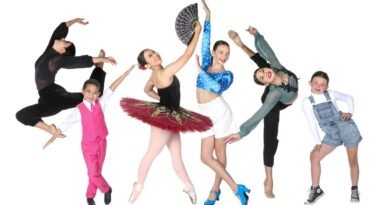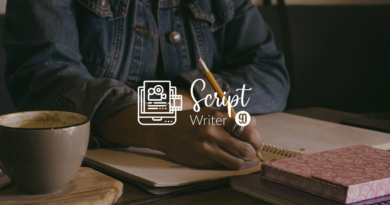What is The Story Boarding Process? What Are The 4 Parts of A Story Board?
Story boarding is a visual planning technique used in film, television, animation, and other visual media to map out the story and plan the visual and narrative elements of a project. The storyboard is essentially a sequence of illustrations or images that show the key moments and scenes of a story, and help to visualize how the final product will look and feel.
The storyboard process typically begins with a script or treatment, which outlines the basic story and structure of the project. From there, the storyboard artist or team will work to develop a series of images that capture the key moments and scenes of the story, and help to visualize the pacing, composition, and overall tone of the project.

Here are the key steps in the storyboard process:
- Review the script or treatment The first step in the storyboard process is to review the script or treatment and identify the key scenes, characters, and visual elements that need to be captured in the storyboard. This involves breaking the story down into individual beats and moments, and identifying the key actions, emotions, and interactions that need to be conveyed visually.
- Develop a shot list Once the key scenes and moments have been identified, the storyboard artist or team will develop a shot list, which outlines the individual shots or frames that will be used to capture each moment. This involves thinking about the camera angles, composition, and visual style of each shot, and how they will work together to tell the story.
- Create rough sketches With the shot list in hand, the storyboard artist or team will begin to create rough sketches of each shot, working to capture the key elements of the scene and convey the necessary information and emotions. These sketches may be done by hand or digitally, and can range from quick thumbnail sketches to more detailed drawings or digital mockups.
- Refine the sketches Once the rough sketches are complete, the storyboard artist or team will begin to refine and finalize the drawings, adding more detail and nuance to the images and working to capture the desired pacing, composition, and tone. This may involve revising the initial sketches based on feedback from the director or other members of the team, and refining the images until they accurately capture the intended vision for the project.
- Add dialogue and sound effects In addition to the visual elements, the storyboard may also include dialogue and sound effects, which help to convey the tone, mood, and atmosphere of the scene. This may involve adding dialogue bubbles or captions to the images, or including notes on the sound effects or music that will be used in the final project.
- Review and revise Once the storyboard is complete, it will be reviewed by the director, producer, and other members of the team to ensure that it accurately captures the vision and tone of the project. Feedback may be provided on the pacing, composition, dialogue, and other elements of the storyboard, and revisions may be made as necessary to ensure that the final project meets the desired creative and technical standards.
Overall, the storyboard process is a critical step in the development of any visual media project, as it helps to map out the story, pacing, and visual elements of the project and ensure that everyone on the team is aligned on the creative vision for the project. By breaking the story down into individual moments and visualizing the key elements of each scene, the storyboard helps to ensure that the final product is engaging, compelling, and visually striking.
What Are The 4 Parts of A Story Board?
A storyboard is a visual representation of a story, often used in film, television, animation, and other visual media. It is made up of a series of images or frames that illustrate the key scenes and moments of a story, and help to plan the visual and narrative elements of a project. A typical storyboard is divided into four main parts, each of which plays an important role in telling the story.

- Visuals The visuals are the most important part of the storyboard, as they capture the key scenes and moments of the story and help to visualize the overall look and feel of the project. Each frame in the storyboard represents a single shot or image, and includes details such as the camera angle, composition, lighting, and visual style of the scene. The visuals may be sketched by hand or created digitally, and should be clear, concise, and visually compelling.
- Dialogue In addition to the visuals, the storyboard may also include dialogue, which helps to convey the emotions, motivations, and actions of the characters in the story. Dialogue may be represented in the storyboard through speech bubbles, captions, or notes, and should be concise, clear, and accurate to the script or treatment. Dialogue also helps to convey the pacing, tone, and overall mood of the story.
- Sound effects Sound effects are an important part of many visual media projects, and may be included in the storyboard to help convey the atmosphere and mood of the story. Sound effects may be represented through notes or captions, and may include details such as music cues, ambient noise, or other sounds that help to enhance the visual experience of the project.
- Camera movement and transitions Camera movement and transitions are key elements of many visual media projects, and may be included in the storyboard to help plan the pacing, rhythm, and overall flow of the project. Camera movement and transitions may be represented through arrows or notes on the storyboard, and may include details such as zooms, pans, cuts, or fades. These elements help to ensure that the final project is engaging, visually compelling, and tells the story in an effective and engaging way.

Overall, the four parts of a storyboard – visuals, dialogue, sound effects, and camera movement/transitions – work together to create a cohesive and compelling visual representation of a story. By breaking the story down into individual moments and images, the storyboard helps to plan the pacing, composition, and overall tone of the project, and ensures that all members of the team are aligned on the creative vision for the project.
Story boarding is a visual planning technique used in film, television, animation, and other visual media to map out the story and plan the visual and narrative elements of a project. The storyboard is essentially a sequence of illustrations or images that show the key moments and scenes of a story, and help to visualize how the final product will look and feel.
The storyboard process typically begins with a script or treatment, which outlines the basic story and structure of the project. From there, the storyboard artist or team will work to develop a series of images that capture the key moments and scenes of the story, and help to visualize the pacing, composition, and overall tone of the project.

Here are the key steps in the storyboard process:
- Review the script or treatment The first step in the storyboard process is to review the script or treatment and identify the key scenes, characters, and visual elements that need to be captured in the storyboard. This involves breaking the story down into individual beats and moments, and identifying the key actions, emotions, and interactions that need to be conveyed visually.
- Develop a shot list Once the key scenes and moments have been identified, the storyboard artist or team will develop a shot list, which outlines the individual shots or frames that will be used to capture each moment. This involves thinking about the camera angles, composition, and visual style of each shot, and how they will work together to tell the story.
- Create rough sketches With the shot list in hand, the storyboard artist or team will begin to create rough sketches of each shot, working to capture the key elements of the scene and convey the necessary information and emotions. These sketches may be done by hand or digitally, and can range from quick thumbnail sketches to more detailed drawings or digital mockups.
- Refine the sketches Once the rough sketches are complete, the storyboard artist or team will begin to refine and finalize the drawings, adding more detail and nuance to the images and working to capture the desired pacing, composition, and tone. This may involve revising the initial sketches based on feedback from the director or other members of the team, and refining the images until they accurately capture the intended vision for the project.
- Add dialogue and sound effects In addition to the visual elements, the storyboard may also include dialogue and sound effects, which help to convey the tone, mood, and atmosphere of the scene. This may involve adding dialogue bubbles or captions to the images, or including notes on the sound effects or music that will be used in the final project.
- Review and revise Once the storyboard is complete, it will be reviewed by the director, producer, and other members of the team to ensure that it accurately captures the vision and tone of the project. Feedback may be provided on the pacing, composition, dialogue, and other elements of the storyboard, and revisions may be made as necessary to ensure that the final project meets the desired creative and technical standards.
Overall, the storyboard process is a critical step in the development of any visual media project, as it helps to map out the story, pacing, and visual elements of the project and ensure that everyone on the team is aligned on the creative vision for the project. By breaking the story down into individual moments and visualizing the key elements of each scene, the storyboard helps to ensure that the final product is engaging, compelling, and visually striking.
What Are The 4 Parts of A Story Board?
A storyboard is a visual representation of a story, often used in film, television, animation, and other visual media. It is made up of a series of images or frames that illustrate the key scenes and moments of a story, and help to plan the visual and narrative elements of a project. A typical storyboard is divided into four main parts, each of which plays an important role in telling the story.

- Visuals The visuals are the most important part of the storyboard, as they capture the key scenes and moments of the story and help to visualize the overall look and feel of the project. Each frame in the storyboard represents a single shot or image, and includes details such as the camera angle, composition, lighting, and visual style of the scene. The visuals may be sketched by hand or created digitally, and should be clear, concise, and visually compelling.
- Dialogue In addition to the visuals, the storyboard may also include dialogue, which helps to convey the emotions, motivations, and actions of the characters in the story. Dialogue may be represented in the storyboard through speech bubbles, captions, or notes, and should be concise, clear, and accurate to the script or treatment. Dialogue also helps to convey the pacing, tone, and overall mood of the story.
- Sound effects Sound effects are an important part of many visual media projects, and may be included in the storyboard to help convey the atmosphere and mood of the story. Sound effects may be represented through notes or captions, and may include details such as music cues, ambient noise, or other sounds that help to enhance the visual experience of the project.
- Camera movement and transitions Camera movement and transitions are key elements of many visual media projects, and may be included in the storyboard to help plan the pacing, rhythm, and overall flow of the project. Camera movement and transitions may be represented through arrows or notes on the storyboard, and may include details such as zooms, pans, cuts, or fades. These elements help to ensure that the final project is engaging, visually compelling, and tells the story in an effective and engaging way.

Overall, the four parts of a storyboard – visuals, dialogue, sound effects, and camera movement/transitions – work together to create a cohesive and compelling visual representation of a story. By breaking the story down into individual moments and images, the storyboard helps to plan the pacing, composition, and overall tone of the project, and ensures that all members of the team are aligned on the creative vision for the project.
Story boarding is a visual planning technique used in film, television, animation, and other visual media to map out the story and plan the visual and narrative elements of a project. The storyboard is essentially a sequence of illustrations or images that show the key moments and scenes of a story, and help to visualize how the final product will look and feel.
The storyboard process typically begins with a script or treatment, which outlines the basic story and structure of the project. From there, the storyboard artist or team will work to develop a series of images that capture the key moments and scenes of the story, and help to visualize the pacing, composition, and overall tone of the project.

Here are the key steps in the storyboard process:
- Review the script or treatment The first step in the storyboard process is to review the script or treatment and identify the key scenes, characters, and visual elements that need to be captured in the storyboard. This involves breaking the story down into individual beats and moments, and identifying the key actions, emotions, and interactions that need to be conveyed visually.
- Develop a shot list Once the key scenes and moments have been identified, the storyboard artist or team will develop a shot list, which outlines the individual shots or frames that will be used to capture each moment. This involves thinking about the camera angles, composition, and visual style of each shot, and how they will work together to tell the story.
- Create rough sketches With the shot list in hand, the storyboard artist or team will begin to create rough sketches of each shot, working to capture the key elements of the scene and convey the necessary information and emotions. These sketches may be done by hand or digitally, and can range from quick thumbnail sketches to more detailed drawings or digital mockups.
- Refine the sketches Once the rough sketches are complete, the storyboard artist or team will begin to refine and finalize the drawings, adding more detail and nuance to the images and working to capture the desired pacing, composition, and tone. This may involve revising the initial sketches based on feedback from the director or other members of the team, and refining the images until they accurately capture the intended vision for the project.
- Add dialogue and sound effects In addition to the visual elements, the storyboard may also include dialogue and sound effects, which help to convey the tone, mood, and atmosphere of the scene. This may involve adding dialogue bubbles or captions to the images, or including notes on the sound effects or music that will be used in the final project.
- Review and revise Once the storyboard is complete, it will be reviewed by the director, producer, and other members of the team to ensure that it accurately captures the vision and tone of the project. Feedback may be provided on the pacing, composition, dialogue, and other elements of the storyboard, and revisions may be made as necessary to ensure that the final project meets the desired creative and technical standards.
Overall, the storyboard process is a critical step in the development of any visual media project, as it helps to map out the story, pacing, and visual elements of the project and ensure that everyone on the team is aligned on the creative vision for the project. By breaking the story down into individual moments and visualizing the key elements of each scene, the storyboard helps to ensure that the final product is engaging, compelling, and visually striking.
What Are The 4 Parts of A Story Board?
A storyboard is a visual representation of a story, often used in film, television, animation, and other visual media. It is made up of a series of images or frames that illustrate the key scenes and moments of a story, and help to plan the visual and narrative elements of a project. A typical storyboard is divided into four main parts, each of which plays an important role in telling the story.

- Visuals The visuals are the most important part of the storyboard, as they capture the key scenes and moments of the story and help to visualize the overall look and feel of the project. Each frame in the storyboard represents a single shot or image, and includes details such as the camera angle, composition, lighting, and visual style of the scene. The visuals may be sketched by hand or created digitally, and should be clear, concise, and visually compelling.
- Dialogue In addition to the visuals, the storyboard may also include dialogue, which helps to convey the emotions, motivations, and actions of the characters in the story. Dialogue may be represented in the storyboard through speech bubbles, captions, or notes, and should be concise, clear, and accurate to the script or treatment. Dialogue also helps to convey the pacing, tone, and overall mood of the story.
- Sound effects Sound effects are an important part of many visual media projects, and may be included in the storyboard to help convey the atmosphere and mood of the story. Sound effects may be represented through notes or captions, and may include details such as music cues, ambient noise, or other sounds that help to enhance the visual experience of the project.
- Camera movement and transitions Camera movement and transitions are key elements of many visual media projects, and may be included in the storyboard to help plan the pacing, rhythm, and overall flow of the project. Camera movement and transitions may be represented through arrows or notes on the storyboard, and may include details such as zooms, pans, cuts, or fades. These elements help to ensure that the final project is engaging, visually compelling, and tells the story in an effective and engaging way.

Overall, the four parts of a storyboard – visuals, dialogue, sound effects, and camera movement/transitions – work together to create a cohesive and compelling visual representation of a story. By breaking the story down into individual moments and images, the storyboard helps to plan the pacing, composition, and overall tone of the project, and ensures that all members of the team are aligned on the creative vision for the project.








